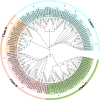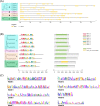Genome-wide identification of MAPK family in papaya (Carica papaya) and their involvement in fruit postharvest ripening
- PMID: 38262956
- PMCID: PMC10807106
- DOI: 10.1186/s12870-024-04742-0
Genome-wide identification of MAPK family in papaya (Carica papaya) and their involvement in fruit postharvest ripening
Abstract
Background: Papaya (Carica papaya) is an economically important fruit cultivated in the tropical and subtropical regions of China. However, the rapid softening rate after postharvest leads to a short shelf-life and considerable economic losses. Accordingly, understanding the mechanisms underlying fruit postharvest softening will be a reasonable way to maintain fruit quality and extend its shelf-life.
Results: Mitogen-activated protein kinases (MAPKs) are conserved and play essential roles in response to biotic and abiotic stresses. However, the MAPK family remain poorly studied in papaya. Here, a total of nine putative CpMAPK members were identified within papaya genome, and a comprehensive genome-wide characterization of the CpMAPKs was performed, including evolutionary relationships, conserved domains, gene structures, chromosomal locations, cis-regulatory elements and expression profiles in response to phytohormone and antioxidant organic compound treatments during fruit postharvest ripening. Our findings showed that nearly all CpMAPKs harbored the conserved P-loop, C-loop and activation loop domains. Phylogenetic analysis showed that CpMAPK members could be categorized into four groups (A-D), with the members within the same groups displaying high similarity in protein domains and intron-exon organizations. Moreover, a number of cis-acting elements related to hormone signaling, circadian rhythm, or low-temperature stresses were identified in the promoters of CpMAPKs. Notably, gene expression profiles demonstrated that CpMAPKs exhibited various responses to 2-chloroethylphosphonic acid (ethephon), 1-methylcyclopropene (1-MCP) and the combined ascorbic acid (AsA) and chitosan (CTS) treatments during papaya postharvest ripening. Among them, both CpMAPK9 and CpMAPK20 displayed significant induction in papaya flesh by ethephon treatment, and were pronounced inhibition after AsA and CTS treatments at 16 d compared to those of natural ripening control, suggesting that they potentially involve in fruit postharvest ripening through ethylene signaling pathway or modulating cell wall metabolism.
Conclusion: This study will provide some valuable insights into future functional characterization of CpMAPKs, and hold great potential for further understanding the molecular mechanisms underlying papaya fruit postharvest ripening.
Keywords: 1-methylcyclopropene (1-MCP); Ethephon; Fruit ripening; Gene expression; Genome-wide analysis; Mitogen-activated protein kinase (MAPK); Papaya.
© 2024. The Author(s).
Conflict of interest statement
The authors declare no competing interests.
Figures







Similar articles
-
Transcription Factor CpbHLH3 and CpXYN1 Gene Cooperatively Regulate Fruit Texture and Counteract 1-Methylcyclopropene Inhibition of Softening in Postharvest Papaya (Carica papaya L.).J Agric Food Chem. 2022 Aug 17;70(32):9919-9930. doi: 10.1021/acs.jafc.2c01908. Epub 2022 Aug 3. J Agric Food Chem. 2022. PMID: 35921197
-
Roles of transcription factor SQUAMOSA promoter binding protein-like gene family in papaya (Carica papaya) development and ripening.Genomics. 2020 Jul;112(4):2734-2747. doi: 10.1016/j.ygeno.2020.03.009. Epub 2020 Mar 16. Genomics. 2020. PMID: 32194147
-
Isolation and characterization of ethylene response factor family genes during development, ethylene regulation and stress treatments in papaya fruit.Plant Physiol Biochem. 2013 Sep;70:81-92. doi: 10.1016/j.plaphy.2013.05.020. Epub 2013 May 25. Plant Physiol Biochem. 2013. PMID: 23770597
-
Fast and Furious: Ethylene-Triggered Changes in the Metabolism of Papaya Fruit During Ripening.Front Plant Sci. 2019 Apr 26;10:535. doi: 10.3389/fpls.2019.00535. eCollection 2019. Front Plant Sci. 2019. PMID: 31105730 Free PMC article. Review.
-
Emerging Roles of Mitogen-Activated Protein Kinase Signaling Pathways in the Regulation of Fruit Ripening and Postharvest Quality.Int J Mol Sci. 2024 Feb 29;25(5):2831. doi: 10.3390/ijms25052831. Int J Mol Sci. 2024. PMID: 38474080 Free PMC article. Review.
Cited by
-
Advances in Protein Kinase Regulation of Stress Responses in Fruits and Vegetables.Int J Mol Sci. 2025 Jan 17;26(2):768. doi: 10.3390/ijms26020768. Int J Mol Sci. 2025. PMID: 39859482 Free PMC article. Review.
-
Genome-wide identification and unveiling the role of MAP kinase cascade genes involved in sugarcane response to abiotic stressors.BMC Plant Biol. 2025 Apr 16;25(1):484. doi: 10.1186/s12870-025-06490-1. BMC Plant Biol. 2025. PMID: 40240958 Free PMC article.
References
MeSH terms
Substances
Grants and funding
LinkOut - more resources
Full Text Sources
Research Materials
Miscellaneous

